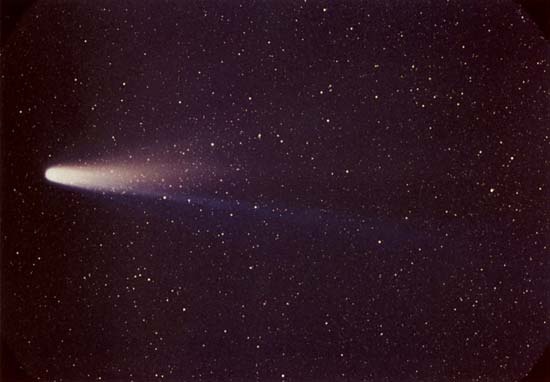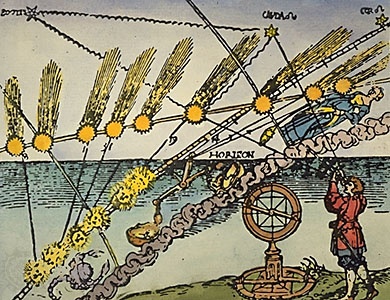Halley's Comet
astronomy
also called Comet Halley


 the first comet whose return was predicted and, almost three centuries later, the first to be photographed up close by spacecraft. In 1705 the English astronomer Edmond Halley (Halley, Edmond) published a work that included his calculations showing that comets observed in 1531, 1607, and 1682 were really one comet and predicting that comet's return in 1758. The comet was sighted late in 1758, passed perihelion (closest distance to the Sun) in March 1759, and was named in Halley's honour. Its periodic returns demonstrated that it was in orbit around the Sun and, thus, that at least some comets are members of the solar system.
the first comet whose return was predicted and, almost three centuries later, the first to be photographed up close by spacecraft. In 1705 the English astronomer Edmond Halley (Halley, Edmond) published a work that included his calculations showing that comets observed in 1531, 1607, and 1682 were really one comet and predicting that comet's return in 1758. The comet was sighted late in 1758, passed perihelion (closest distance to the Sun) in March 1759, and was named in Halley's honour. Its periodic returns demonstrated that it was in orbit around the Sun and, thus, that at least some comets are members of the solar system.Dozens of earlier passages of Halley's Comet were later calculated and checked against historical records of comet sightings. Its earliest recorded appearance, witnessed by Chinese astronomers, was in 240 BC. Its closest approach to Earth took place in April 837. It was the large, bright comet seen during the Norman Conquest of England (1066) and shown in the Bayeux Tapestry of that time. Its passage in 1301 appears to have inspired the form of the Star of Bethlehem (Bethlehem, Star of) that the Italian painter Giotto (Giotto di Bondone) used in his “The Adoration of the Magi.” Its passages have taken place about 76 years apart on average, but the gravitational influence of the planets on the comet's orbit have caused the orbital period to vary by a year or two from one reappearance to the next. During the comet's return in 1910, Earth probably passed through part of its tail, which was millions of kilometres in length, with no apparent effect.
 As predicted, the comet passed Earth in November–December 1985, reached perihelion on Feb. 9, 1986, and came closest to Earth on April 11, 1986. Its passage was observed by two Japanese spacecraft (Sakigake and Suisei), two Soviet spacecraft (Vega 1 and Vega 2), and a European Space Agency spacecraft ( Giotto). Close-up images of the comet's nucleus made by Giotto show an oblong object with dimensions of about 15 × 8 km (9 × 5 miles). As expected, the nucleus proved to be a mixture of frozen water, other volatile ices, and rocky (silicate) particles; this was covered with an irregular crust having several large vents from which jets of steam, other gases, and dust escaped. Surprisingly, the crust turned out to be very black, apparently from a surface coating of less-volatile carbon compounds. High heat absorption by the dark surface was thought to explain a temperature of 350 K (170 °F, 80 °C) measured for the comet when it was 0.9 AU (135 million km 【84 million miles】) from the Sun. As the comet rotated on its axis, the rate of dust and gas emission were observed to increase on the sunward side and then to drop off quickly as that side turned toward the darkness. Dust particles shed during the comet's slow disintegration over the millennia are distributed along its orbit. The passage of Earth through this debris stream every year is responsible for the Orionid and Eta Aquarid meteor showers in October and May, respectively.
As predicted, the comet passed Earth in November–December 1985, reached perihelion on Feb. 9, 1986, and came closest to Earth on April 11, 1986. Its passage was observed by two Japanese spacecraft (Sakigake and Suisei), two Soviet spacecraft (Vega 1 and Vega 2), and a European Space Agency spacecraft ( Giotto). Close-up images of the comet's nucleus made by Giotto show an oblong object with dimensions of about 15 × 8 km (9 × 5 miles). As expected, the nucleus proved to be a mixture of frozen water, other volatile ices, and rocky (silicate) particles; this was covered with an irregular crust having several large vents from which jets of steam, other gases, and dust escaped. Surprisingly, the crust turned out to be very black, apparently from a surface coating of less-volatile carbon compounds. High heat absorption by the dark surface was thought to explain a temperature of 350 K (170 °F, 80 °C) measured for the comet when it was 0.9 AU (135 million km 【84 million miles】) from the Sun. As the comet rotated on its axis, the rate of dust and gas emission were observed to increase on the sunward side and then to drop off quickly as that side turned toward the darkness. Dust particles shed during the comet's slow disintegration over the millennia are distributed along its orbit. The passage of Earth through this debris stream every year is responsible for the Orionid and Eta Aquarid meteor showers in October and May, respectively.Halley's Comet is next expected to return to the inner solar system in 2061.
- Las Hurdes
- LASIK
- Lasker, Albert
- Lasker, Eduard
- Lasker, Emanuel
- Lasker-Schüler, Else
- La Skhira
- Laski, Harold Joseph
- Las Marismas
- Las Palmas
- Laspeyres index
- La Spezia
- Las Piedras
- Las Posadas
- Lassa Francis Lawrence Oppenheim
- Lassalle, Ferdinand
- Lassell, William
- Lassen Peak
- Lasse Virén
- Lassois, Mont
- Lasso, Orlando di
- Lasswell, Harold Dwight
- Las Tablas
- La Stampa
- Last Judgment